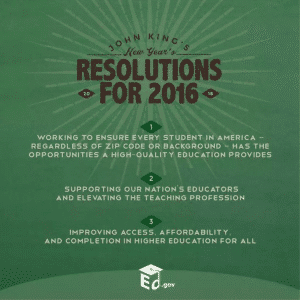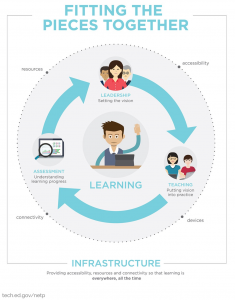Providing Transformative Personalized Student Learning Opportunities as a Path Toward Equity
Education Domain Blog
This blog was originally posted on the Office of Ed Tech blog on Monday, April 11, 2016.
Promoting equity and excellence at every level of education to ensure that every child has the opportunity to succeed is one of U.S. Secretary of Education John King’s top three priorities over the coming year. How can new instructional models provide more powerful, personalized learning experiences driven by learner needs and interests to ensure innovation for equity?
 By designing personalized learning models, students can get the necessary interventions and supports exactly when they need them to meet their learning goals. Educators using technology are empowered and are better able to meet each student’s needs. These models can transform K-12 education and improve the educational outcomes of all students. Educators are personalizing learning with focused interventions, differentiated instruction and supports to meet the specific needs of historically underserved populations. By meeting kids where they are and using advanced technologies, students are able to achieve dramatically improved outcomes and experience successful attainment of learning goals. As Ty Cesene, Co-Director of Bronx Arena, stated,
By designing personalized learning models, students can get the necessary interventions and supports exactly when they need them to meet their learning goals. Educators using technology are empowered and are better able to meet each student’s needs. These models can transform K-12 education and improve the educational outcomes of all students. Educators are personalizing learning with focused interventions, differentiated instruction and supports to meet the specific needs of historically underserved populations. By meeting kids where they are and using advanced technologies, students are able to achieve dramatically improved outcomes and experience successful attainment of learning goals. As Ty Cesene, Co-Director of Bronx Arena, stated,
“We aren’t done innovating until 100% of our students are graduating.”
To drive this shift toward equitable, personalized K-12 education systems, strong leadership is essential. There is a tremendous mindset shift required from using tools and resources for compliance to continuous improvement with a focus on empowerment through personalized learning. As many districts and schools begin this transformation toward implementing high-quality personalized learning opportunities for all students, leaders and educators need to develop the capacity to both design for equity and accelerate this shift to ensure that success is the only option.
How Can Technology Help Us to Meet this Goal?
The 2016 National Education Technology Plan sets a vision of equity that includes providing transformative learning opportunities grounded in the experience of the learner. When aligned with key learning outcomes, technology allows for greater access to digital resources, while adaptive learning can help pinpoint a student’s level of mastery and create targeted recommendations for interventions.
 Developing leader and educator capacity in powerful, personalized learning models can ignite the shift toward providing learner-centered experiences for all students. By re-designing the system with equity at the forefront, we can prepare each student for success in college, career and citizenship.
Developing leader and educator capacity in powerful, personalized learning models can ignite the shift toward providing learner-centered experiences for all students. By re-designing the system with equity at the forefront, we can prepare each student for success in college, career and citizenship.
To help grow district leader capacity and prepare superintendents for systemic change, the U.S. Department of Education’s Office of Educational Technology recently released Personalized Professional Learning for Future Ready Leaders. This new set of tools supports superintendents as they develop plans to implement research-based digital learning strategies to provide equitable access to transformative learning experiences for all students.
Exemplary Personalized Student Learning policies and practices, as defined in this research synthesis developed to validate and inform the work of this project, are demonstrated in leaders who:
- Develop rigorous and relevant learning outcomes to guide instruction
- Support integrated assessments
- Provide competency-based learning pathways
- Create powerful learning designs where students learn through a diverse set of activities
- Provide on-demand access to high-quality, outcomes-aligned learning resources
- Foster a culture that supports new roles for teachers
Stories of Transformative Personalized Student Learning
Learning Without Boundaries
“School” is no longer defined merely as a physical space, classrooms lined with rows of desks and a teacher who lectures at the front of the room — nor does a student’s required curriculum have to involve a one-size-fits-all model that uses a single textbook. Personalized learning is anytime, anywhere learning in partnership with communities that bridges formal and informal learning experiences through the effective use of advanced technologies.
Future Ready Coalition partner iNACOL, an international nonprofit organization working to advance powerful, personalized, learner-centered experiences through competency-based, blended and online learning, recently released Implementing Competency Education in K-12 Systems: Insights from Local Leaders. This report maps out district implementation strategies being used to convert traditional, time-based systems of education into personalized, competency-based learning infrastructures. In the report, Bill Zima, Principal of Mt. Ararat Middle School, described learning without boundaries as follows:
“As the navigators of learning, our role isn’t to march students to their destinations, but to provide the feedback they need to get there themselves. While we try to keep them all on the path, we know that we will have some who will want to stop to smell the flowers… Nothing works for all students. But if we know where we need to get them, it makes it easier to guide them.”
The report also tells the story of how Sanborn Regional High School designed Freshmen Learning Communities to help ninth graders build the 21st century skills they need for success and identify where students need additional support. They are finding that the conversations about students with special education needs are more focused on learning and progress than behaviors. Since this discovery, the understanding of standards, of differentiated instruction, and of accommodations for assessments has become much more clear and intentional.
Kettle Moraine, a Future Ready district, created a district-wide personalized student learning program focused on learning without boundaries.
“Personalized learning is allowing the individual their voice and their interest to drive the learning and to not be bound by, ‘This is how school looks. This is what we’re gonna learn at this time, my way.’ So there are no boundaries. Students can come in with their ideas, and they co-create their learning plans with the teacher.”
-Theresa Ewald, Assistant Superintendent of Teaching and Learning, Kettle Moraine School District
Powerful Learning Designs
The leadership team at St. Vrain Valley, a Future Ready District, created a system that supports personalized student learning from start to finish, including a career pathway focus and design thinking.
“We have a whole host of opportunities that are available for kids, where they can take a look at what they think about, what they like, where their passion lies, where their aptitude is. And then can pursue that. We open choice up, we open the boundaries up, and we let kids pursue these areas that they’re interested in. And we expect them to own it and to take the responsibility for their learning. You have to develop a system that promotes engagement.”
-Don Haddad, Superintendent, St. Vrain Valley School District
In iNACOL’s Implementing Competency Education report, Doug Penn, District Principal for Chugach School District, shared his priorities for developing powerful learning designs:
“Our community told us they wanted their children to be lifelong learners. We had to ask ourselves, what are we doing in our classrooms to help them be lifelong learners? What structures and supports do our teachers need to help develop lifelong learners? It came down to needing to have an active learning environment. Students need to be able to seek out things they are personally interested in, create a plan, and find the resources. We are always looking for ways for students to learn beyond the classroom.”
Personalized Learning Tied to Student Interests and Passion
By providing students with ownership over their education, they experience empowerment, design their learning around their strengths, needs, interests and experiences, and guide their own learning pathways with a new, invigorating sense of responsibility.
iNACOL’s Mean What You Say report describes this phenomenon: “The purpose of the personalized learning framework is to open student pathways and encourage student voice and choice in their education. Personalized learning is enabled by instructional environments that are competency-based. By tapping into modalities of blended and online learning using advanced technologies, personalized learning is enhanced by transparent data and abundant content resources flowing from redesigned instructional models to address the standards. By doing this, new school models can unleash the potential of each and every student in ways never before possible.”
As Sara Grimm, Elementary Principal and Director of Teaching and Learning at Howard-Winneshiek Community School District states in the following Future Ready Leaders video,
“It’s not about covering material, it’s about uncovering what the students know.”
District leaders and educators can create more equitable K-12 systems through personalized learning and prepare every student for success in college, career and citizenship. To create this systemic change, we must build leader and educator capacity. Together, we can catalyze the transformation of K-12 education and equip students with the knowledge, skills and habits to lead successful, productive lives.
The iNACOL Blended and Online Learning Symposium in San Antonio, Texas on October 25–28, 2016, will convene 3,400 education leaders, policymakers, educators and innovators to provide students with powerful, personalized transformative learning opportunities. Join iNACOL in catalyzing the transformation of K-12 education through competency-based, blended and online learning. Learn more and register to attend here.
Additional leadership resources are available from our other Future Ready Coalition Partners. Additional Future Ready Tools, including a comprehensive interactive planning tool called the Planning Dashboard, a new one-stop Hub for district leaders’ ongoing professional learning activities, and in-person summits and workshops, are also available.
Please continue to join the Office of Educational Technology throughout the month of April as we blog, tweet, chat and engage around all four of the key focus areas of becoming Future Ready: Collaborative Leadership, Robust Infrastructure, Personalized Student Learning, and Personalized Professional Learning. Visit tech.ed.gov/leaders/.